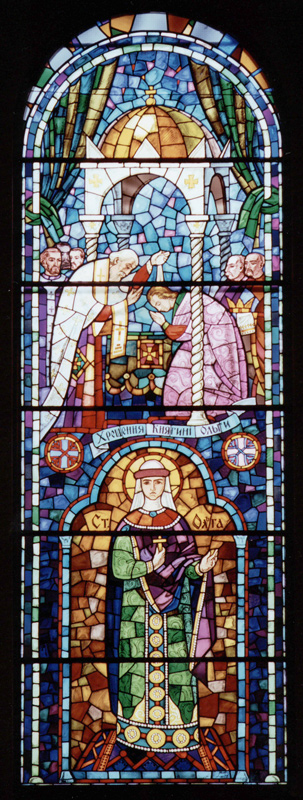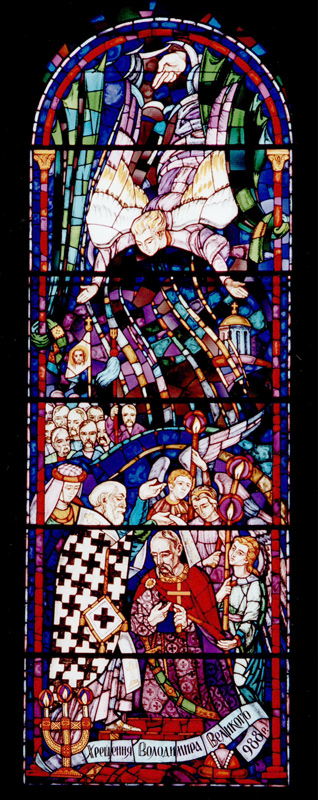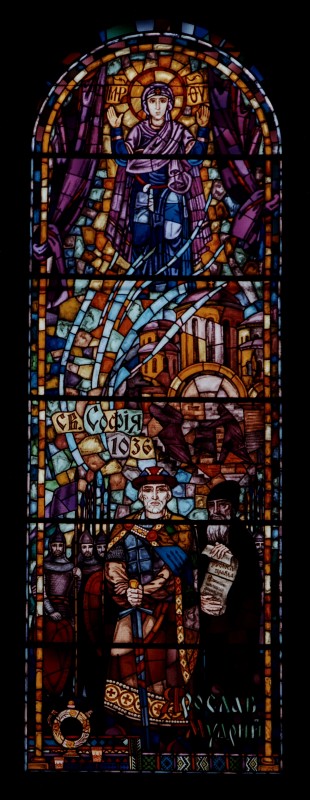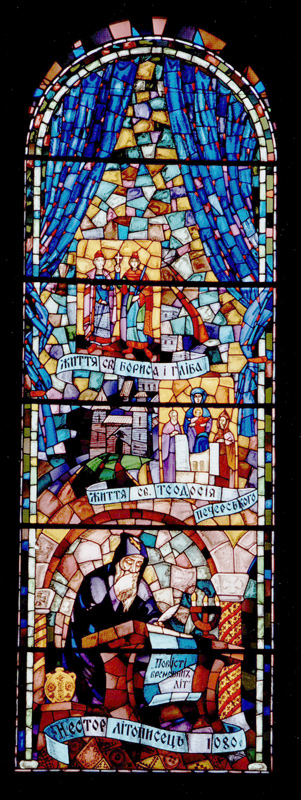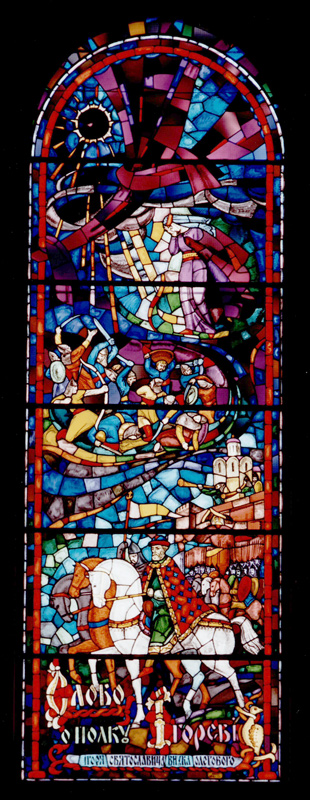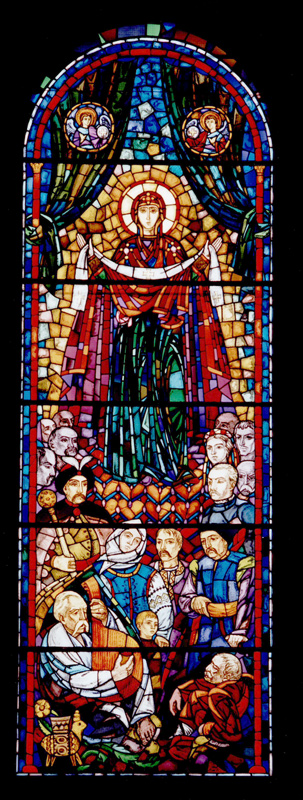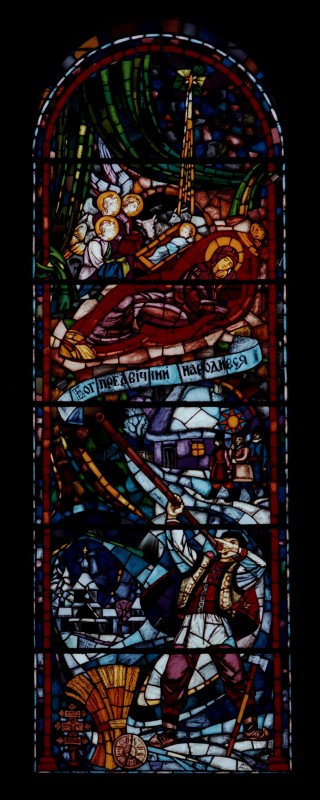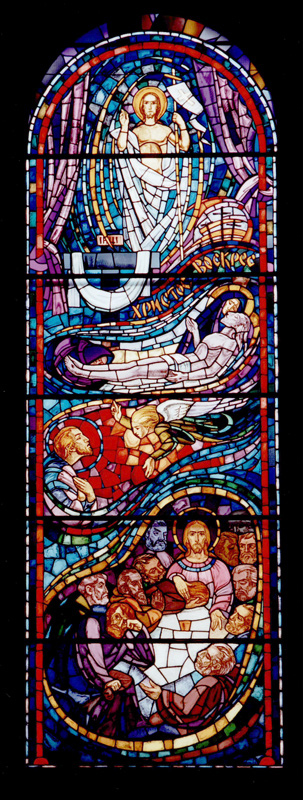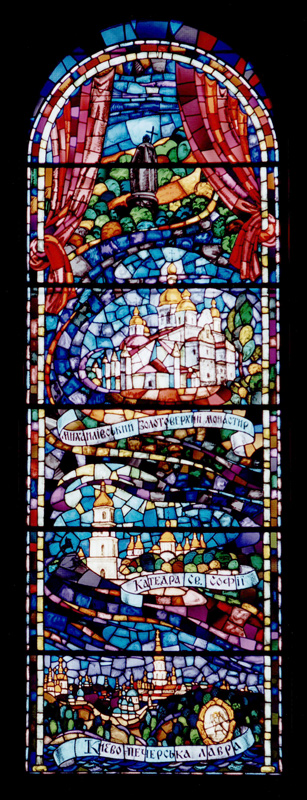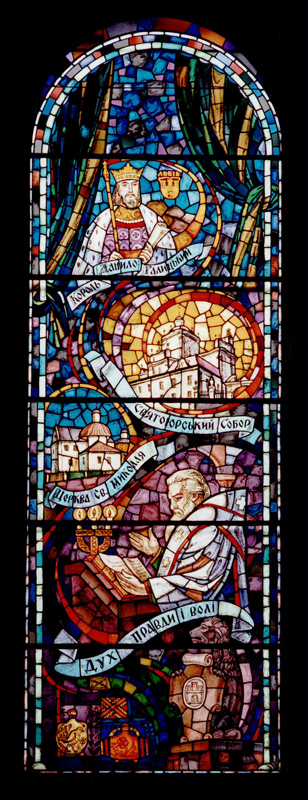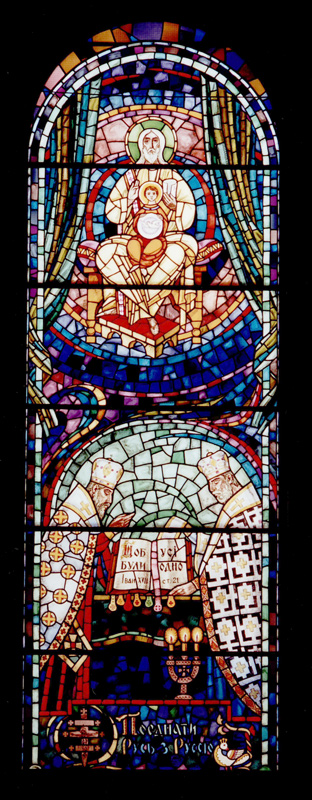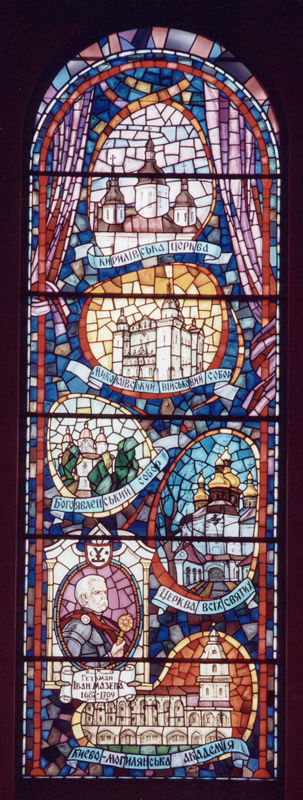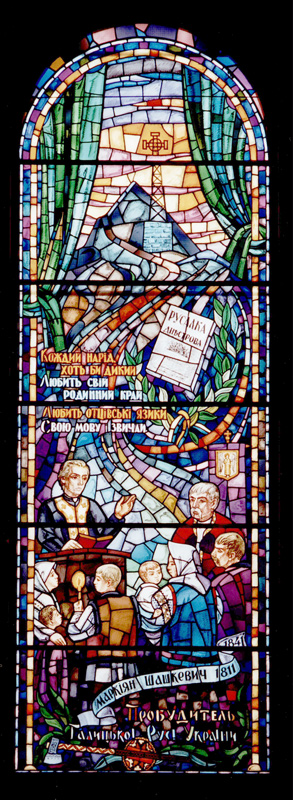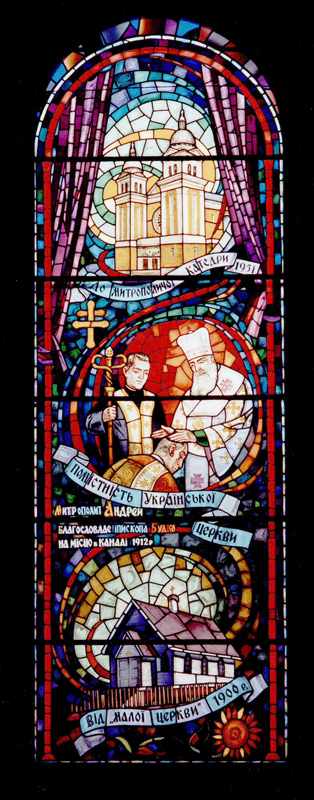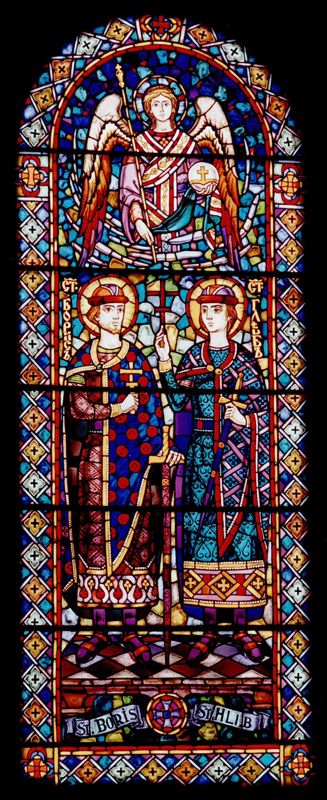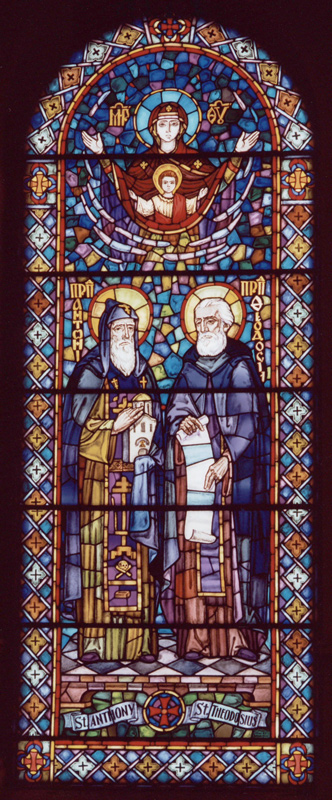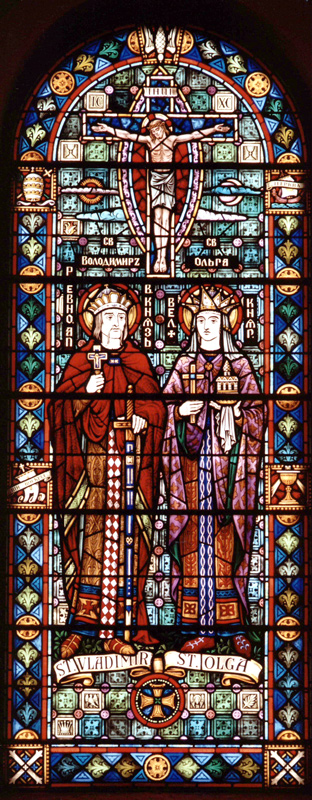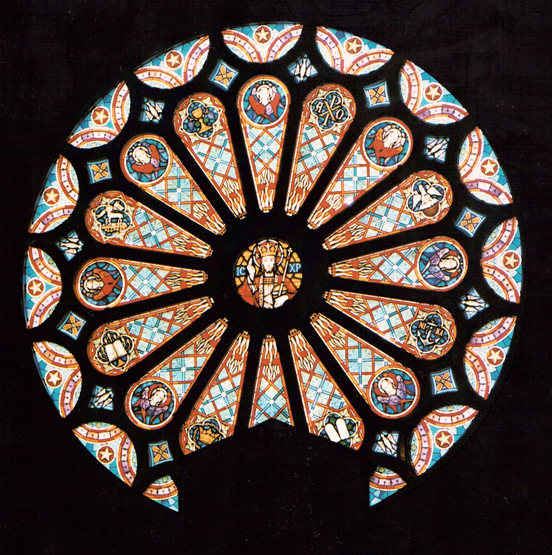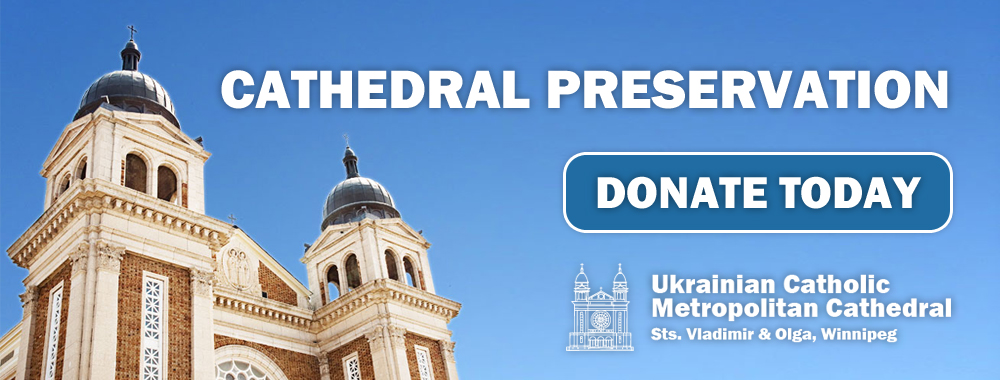Stained Glass - Details & Photos
The Baptism of Princess Olga
Princess Olga is the first of the royal family to have accepted the Christian faith. According to the writings of the historian-monk Nestor, she received her baptism in the year 955 during her stay in Constantinople. This window shows that Princess Olga received the Holy Sacrament of baptism from Patriarch Theofilakt in the company of her entourage of 63 persons and her chaplain Fr. Hryhorij. The Patriarch is shown in the window by the signs of his office - the omophorion and the nebedrynyk.
The lower section of the window details the icon of St. Olga, covered by a halo and holding a cross in her right hand, spreads the Good News of her newly accepted Christian faith. The bright coloring in the background brings into relief the grace of the Holy Spirit at the time of her baptism.
The Baptism of Vladimir the Great
The next important historical event in the christianization of the Ukraine is the baptism of the great prince, St. Vladimir. Before officially introducing the Christian faith to his subjects in the year 988, he shows his leadership by first receiving the sacrament of baptism. The baptism of St. Vladimir is detailed on the window as such an important event that even the heavenly powers participated. Angels descended from above bearing candles with a halo. An angel hovering overhead symbolizes the Lord's Blessing upon the ruler of the people. In the ceremony of baptism, St. Vladimir receives the blessing of the bishop, his Christian name of Wasyl, and his head is covered by the bishop's vestment showing his temporal and spiritual powers over his subjects.
In the background of this important event, the Church of the Blessed Virgin can be seen. This Church was constructed in the year 996 by St. Vladimir who donated 1/10 of his wealth for the building of this Church.
Although the time of St. Vladimir's baptism is disputed by historians, most agree that it occurred in the year 988. The place of his baptism is considered to have been either in Kyiv itself, or Korsun, or Wasyliw. It is recorded that St. Vladimir who had taken the Christian name of Wasyl, reigned on his throne for 28 years after his baptism.
Jaroslaw the Wise
The two inscriptions on this window signify the rule of Prince Jaroslaw the Wise and his monumental achievement - the building of the Cathedral of the Holy Spirit (Sviata, or Saint Sophia) which was constructed in 1036.
This scene depicts the rule of a very wise and great prince (1019-1054). Combining his wisdom with the sword, Prince Jaroslaw was able to expand the empire he inherited from his father, Prince Vladimir the Great. This portion of the window presents Jaroslaw as a soldier and a leader of his people. This onerous duty is symbolized by the heavy sword which he carries in his hand. His wisdom is signified by the scroll which is carried by a monk and which is titled "Ruska Pravda" which was one of the first written codes of law in Ukraine.
Since Prince Jaroslaw was especially devoted to the Blessed Virgin Mary, he placed his country under her protection. In her honor he built the Church of the Annunciation.
Historians refer to the reign of Prince Jaroslaw as the "Golden Age". For that reason this window is unique for its golden coloring.
Mrs. Sophia Dowhoshyja was the donor of this window.
The Historian Nestor
This window depicts the first Ukrainian historian and author of the book "Chronicles of Olden Days". Nestor was a monk at the Pecherska Lavra which was the centre of religion and culture. Although almost nothing is known about him, it is clear that he was a very religious person who combined his literary skills with his love for God and his country in providing this precious historical documentation.
Nestor, the Historian, wrote other historical documents which are represented in the central section of the window - "The Life of St. Theodosius Pecherski" and in the upper section "The Lives of Borys and Hlib".
Poem about the March into Battle of Prince Ihor
The poem about the march into battle of Prince Ihor was written in 1185 by an unknown poet in the Old Slavonic language about the battle with a nomadic tribe, the Polovtsi, who were on the rampage and were destroying and looting the cities and countryside.
This window represents the tragedy of this event. A bad omen warns the princes before their march into battle - "The sun has grown dark" (probably a solar eclipse). In one section of the window we see the princes prepare for the defence of their country and their Christian faith. The prince of Novhorod, Ihor Svyatoslavech - the hero, his brothers Vsevolod, his son Ihor, and nephew Svyatoslav led the march. "In Novhorod the horns blow" warning everyone that the battalions of soldiers have marched on.
The central window shows the 24 hour with the Polovtsi. The battle ended tragically with only 15 soldiers left alive and Prince Ihor taken into slavery.
In the top section of the window, the wife, Princess Jaroslava of Halych, daughter of Prince Jaroslav Osmomesl, mourns the loss of her husband and son.
The Blessed Virgin of the Cossacks
The Blessed Virgin Mary in this stained glass window portrays the love and devotion the Cossacks held for the Mother of God. The Cossacks showed their gratitude to the Blessed Virgin by erecting in her honor Churches, often named "The Protection of the Mother Of God".
In this design, the Mother of God is represented in an enlarged form as being the intermediary between Heaven and earth. As an intermediary between God and the people, she protects with her hands and mantle the Ukrainian nation.
In her honor a large group of people are gathered to pray, amongst them a bandurist who sings praises to the Virgin Mary and the Hetmans, leaders of the people, who place themselves under the protection of the Blessed Virgin Mary.
Dr. Jaroslaw and Maria Barwinski were the donors of this window.
The Birth of Christ
"GOD ETERNAL IS BORN" is the inscription on this window. These is the traditional Christmas greeting among Ukrainians. This scene has a distinctive Ukrainian character since it represents a Hutsul in the Carpathian Mountains announcing by means of his trembita (a traditional wind instrument) that "God Eternal is Born".
In the evening all the people hurry to attend the Services in the Church. Carollers who are led by the traditional star visit each home and spread joyous news of Christ's birth.
In the top section the Nativity scene shows the Blessed Virgin watching the newly-born Christ and three angels singing the praises "Glory be to God in the Highest". The star shines over the manger - "Over the Manger Shines a Bright Star".
The sheaf of wheat in the corner is representative of the fertile Ukrainian land and symbolizes a gift to the Christ Child from the Ukrainian people.
Mykola and Julia Pomor were the donors of this window.
The Resurrection of Christ
This is the most important Holy Day in the Church calendar. The Resurrection of Christ is presented with the events which occurred during Passion Week. These sufferings of Christ are crowned by the Resurrection which is shown at the very top of the window.
In the bottom section, Jesus blesses the bread and wine at the Last Supper with the words "This is My Body . . . This is My Blood . . ."
The next event takes place also on Holy Thursday. Jesus is alone in deep prayer in the Garden of Gethsemani. His head is shaded in a red tint representing the blood which He sweated while in prayer.
The site of Christ's death on the hill of Golgotha is next. The body of Christ has been taken off the cross and lies nearby. The sorrowful Mother of Christ stands beside her dead Son. This scene represents Good Friday and is expressive of the Plaschanytsia, or Shroud, which is laid out in Churches on this day for the people to worship.
The culminating event is the glorious Resurrection of Christ and the words - "Christ has Risen".
Golden-Domed Kiev
This stained glass window presents a panoramic view of Golden Domed Kyiv. In the lower section, one sees the Pecherska Lavra which is a complex of monasteries begun by Sts. Anthony and Theodosius. It is here that the religious and cultural life of the Ukraine began its development and reached its greatest height. The history of this great centre has been marked by the vicissitudes of war and destruction. However, it was always able to restore itself as a cultural and spiritual centre.
In the centre of the window is the Cathedral of St. Sophia. This is the most important Church in Ukraine and was built by Prince Jaroslaw Mudrij (the Wise) in the 11th century.
In the following section the Monastery of St. Michael Zolotoverkhyj (the Golden Domed St. Michael's) can be seen. This monastery was built soon after St. Sophia in the years 1068-1078.
Finally, the statue of St. Vladimir the Great who introduced Christianity to Ukraine can be seen. This monument was by P. Klodta and erected in 1853. Since Prince Vladimir is regarded as almost equal to an apostle, he bears a large cross indicative of his role in bringing Christianity to Ukraine.
The City of L'viv
The capital city of the Western Ukraine- Lviv, is represented in this window. The founder of this city was King Danylo of Halych whose figure dominates the window. He built this city for his son, Lev in the year 1250. For that reason the city was named L'viv. In 1260 L'viv became the capital city of the Volynsk-Halych state and it remained its capital until 1340.
The Church of St. Nicholas is also seen in this window. It was built by Prince Lev in the 13th century. This Church was destroyed twice in its history and today only the foundations remain. It was last rebuilt in the year 1800.
The most important Church in the city of Lviv is the Cathedral of St. George. This is the Cathedral Church of the Metropolitan-Archbishop of Halych. It was built on a hill overlooking the city at the beginning of the 18th century. The Cathedral has lasted for three centuries and is widely regarded as the centre of the city of Lviv. It is surrounded by other buildings, one of which is the Metropolitan's Palace.
The great Metropolitan, Andrew Sheptycky is also represented in this window. He was the Metropolitan of Halych for 44 years (1900-1944). His life was closely interwoven with the city of Lviv. As priest and Metropolitan he served God and his people for 56 years. The last image is the emblem of the city of Lviv.
Attempts at Religious Unity
The entire window presents the figures of two famous Metropolitan-Archbishops and above them the representation of the Blessed Trinity.
These figures represent two of the most highly respected Metropolitans of Ukraine: Benjamin Rutsky and Petro Mohyla. Both are celebrating the Divine Liturgy. On the altar the Holy Gospel shows the words of Christ: "That all may be one". Both of these Metropolitans attempted to unite the Catholic and Orthodox Churches into one Ukrainian Church in the form of the Patriarchate of Kyiv. Unfortunately, this ideal was not realized.
This event occurred at the beginning of the 17th century. It happened 30 years after the conclusion of the Union of Brest, which divided the Ukrainians into two faiths. Both Metropolitan Archbishops devoted themselves to this religious union at this opportune time so that all may be like brothers.
The Era of Hetman Ivan Mazepa
The era of Hetman Ivan Mazepa (1687-1709) was a period of cultural and political regeneration in the Ukraine.
Because of the initiative and aid of this great Hetman, one of the most important universities arose in Ukraine. This University, called the Kievan-Mohylyanska Academy, was widely recognized throughout Europe. It consisted of schools of higher learning, libraries, and printing shops.
Politically, Ivan Mazepa strived to attain the independence of Ukraine. His plans to achieve this goal were not realized since he lost an important battle near the city of Poltava in the year 1709.
The figure of Mazepa is presented in a medallion in the window. The Academy is in the lower section and in the top section are Churches which feature the Ukrainian barocco style of architecture: All Saints Church, The Church of the Epiphany, St. Nicholas Military Church, and St. Cyril's Church.
Father Markian Shashkewych
This window features a priest who is preaching a sermon. The congregation is listening attentively to the words proclaiming the Word of God.
Father Markian Shashkewych was one of the very first to have used the Ukrainian vernacular language in his sermons and writings. At that time, most of the people had lost their national identity and their language because Ukraine had been under the domination of other countries for many long years. Father Markian was very influential in helping to restore the use of the Ukrainian language and published the first book in the Ukrainian language which was titled "Rusalka Dnistrova" - "The Water nymph of the Dnister".
Father Markian Shashkewych was an intelligent village priest who also was a writer, poet, and Ukrainian patriot. He was of poor health and died at the age of 32 years. He is buried in L'viv.
Several verses of his poem "Rusalka Dnistrova" are depicted in this window. In the top sectionwe see a cross, 25 meters high, that was erected on a hill, near his beloved village of Pidlesya. The people and their clothing are captured in amazing detail in this window.
Dr. Таras and Daria Snihurowych were the donors of this window.
From the Small Church to the Metropolitan Cathedral
This window represents the historical relationship between the Ukrainian Catholic Church in Ukraine and in Canada.
The great Metropolitan of Lviv, Andrew Sheptyckyj and the first bishop for Ukrainians in Canada Nykyta Budka are featured in the central section of this window. Metropolitan Sheptyckyj was one of the principal architects in the creation of the first Ukrainian diocese in Canada. He also consecrated Bishop Budka in the year 1912.
When Bishop Budka arrived in Canada, he found that several churches had already been built and missions organized. One of these churches was Sts. Vladimir and Olga. This is the oldest Ukrainian Catholic Church in Winnipeg. It was begun in the year 1901. In the lower section of the window, the first church of Sts. Vladimir and Olga can be seen in its original form. Beneath is the inscription "From the Small Church".
Bishop Budka chose this Small Church of Sts. Vladimir and Olga to be the pro-Cathedral Church of the diocese. In 1947, his successor, Bishop Wasyl Ladyka, elevated this Church to a Cathedral, and in 1957 the Cathedral received the distinction of being the Metropolitan Church for all Ukrainians in Canada.
The donors of the window were Dr. Dmytro and Hala Charney and Ivan and Olha Hawryluk.
Sts. Boris and Hlib
This stained glass window represents two princely brothers - Boris and Hlib, the sons of Prince Vladimir the Great. Boris, the more capable and beloved of the two, was chosen to reign as prince of "Kyivshchena" by his father. While Boris was protecting his country from the Polovtsi in battle, his father became ill and passed away. Seizing upon this opportunity, Prince Sviatopolk, Boris' uncle, took possession of the throne and had Boris killed. The same fate awaited Hlib. He was sent for on the pretext that his dead father was still dying, and was killed en route to Kyiv, as Sviatopolk wished to be the only ruler of Kiev. The two holy brothers were laid to rest at St. Basil's in Vishorod.
Soon all Ukrainians proclaimed them Saints who "Live in the Kingdom of Heaven praying for their people so that the Lord grants them the grace to live in peace and harmony . . . praying for the freedom of their country."
The window is crowned with the patron saint of the Ukraine - the Archangel Michael.
The donors of this window were Roman (Roy) and Ollie Babick and Dr. Taras and Patrusia Babick.
Sts. Anthony and Theodosius Pecherskyj
This stained glass window depicts two monks - St. Anthony and St. Theodosius Pecherskyj. They're named Pecherskyj because the word is derived from the Ukrainian word pechera meaning "a cave", which in Ukraine are located on the banks of the Dnipro River. Here, in these caves, these two monks laid the foundations for the ascetic monastic life in the Ukraine. In a short time many followers were attracted to this severe monastic form of self discipline.
St. Anthony, who was of Ukrainian descent, began his religious training in a monastery on Mount Athos in Greece. He returned to Ukraine and stayed in a cave with another monk, Ilarion, who later was consecrated Metropolitan of Kiev. Here St. Anthony founded a monastery and was one of the founders of the Pecherska Lavra.
In 1062 St. Theodosius became the superior of the monastery and began the work of updating the code of monastic rules. A short time later he built the present day Pecherska Lavra.
Above the saints can be seen the Blessed Virgin Virgin with the infant Christ in her arms.
Sts. Vladimir and Olga
Sts. Vladimir and Olga are the patron saints of this Cathedral. For that reason this important window is placed directly behind the altar. In Ukrainian Churches the patron saint of the Church is always represented behind the altar. Since these saints are the ones who introduced Christianity to Ukraine, it is appropriate that the first Ukrainian Church in Winnipeg is placed under their patronage. It was designed and created in New York and installed for the consecration of the cathedral in 1951. Further information on these patron saints is given in the windows depicting "the Baptism of St. Vladimir the Great and the Baptism of Princess Olga".
The Rosette Window
The Rosette Window is located above the choir loft. It was designed and executed in New York and installed in 1951. It shows the central figure of Jesus Christ. In the panels encircling Christ are various symbols of ancient Christianity.
Stained Glass Window Gallery
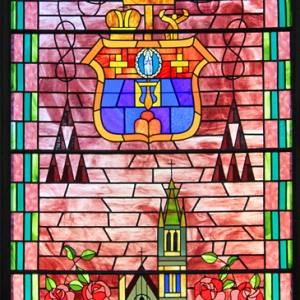 |
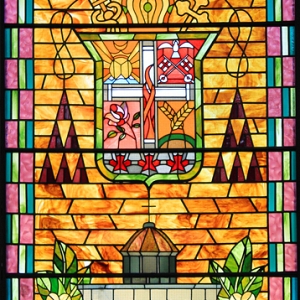 |
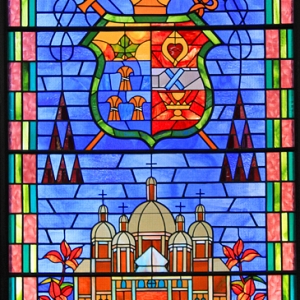 |
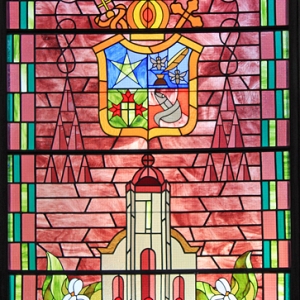 |
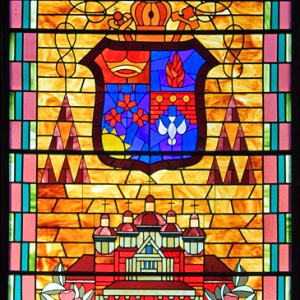 |
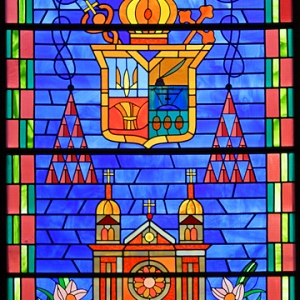 |
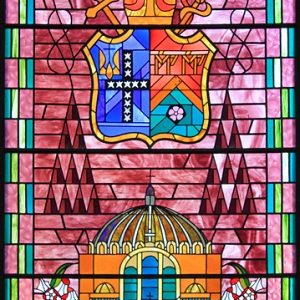 |
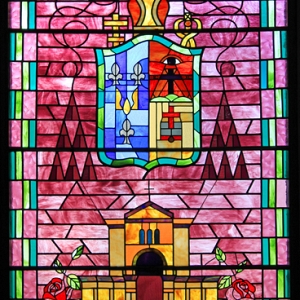 |
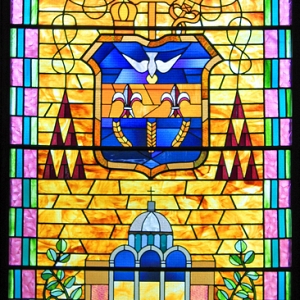 |
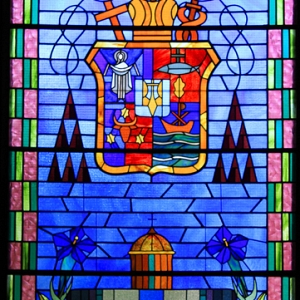 |
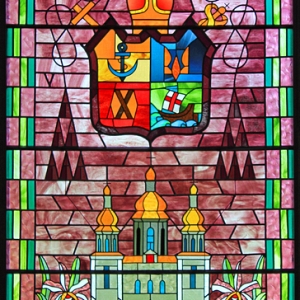 |
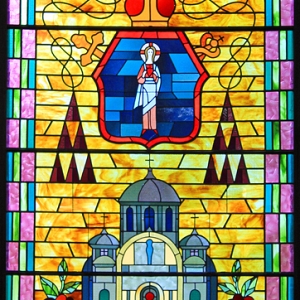 |
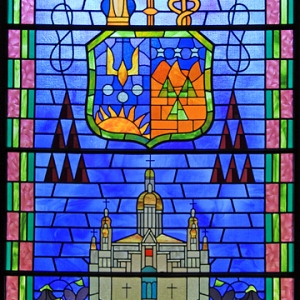 |
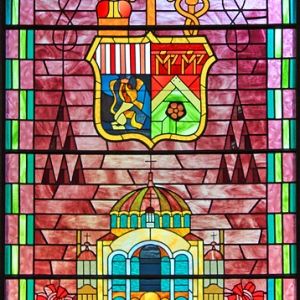 |
